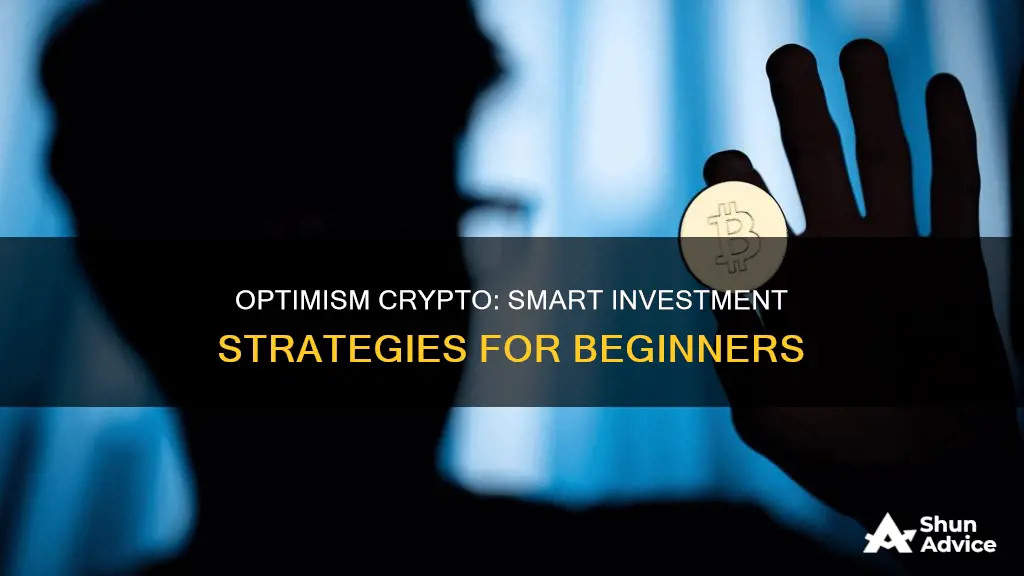
Optimism is an Ethereum-based decentralised infrastructure platform that allows for instant transactions and scalable smart contracts. It is a public benefit corporation, a for-profit corporation that balances the interests of stockholders with those of the community and society. Optimism is developing Optimistic Rollup, a scaling solution that aggregates transactions onto a Layer 2 protocol, with the aim of boosting the scalability of Ethereum and reducing the high costs of transacting on the network. The company raised $25 million in Series A funding in 2021, led by Andreessen Horowitz, and has since sold $89 million OP tokens in a private transaction.
What You'll Learn

Instant transactions and low fees
Firstly, Optimism guarantees instant transactions. Blocks are constructed and executed on the L2 (Optimism), while user transactions are batched up and submitted to the L1 (Ethereum). The L2 has no mempool, and transactions are immediately accepted or rejected, ensuring a smooth user experience.
Secondly, Optimism offers significantly lower fees compared to Ethereum. As a layer-two solution, Optimism can support 500-2000 TPS (transactions per second) with fees of less than a cent, while maintaining security and decentralization. The gas price on OP Mainnet is much lower than on Ethereum, resulting in substantial cost savings for users.
The transaction fees on OP Mainnet are composed of two parts: the Execution Gas Fee and the L1 Data Fee. The Execution Gas Fee is the same as what you would pay for the same transaction on Ethereum. However, since the gas price on OP Mainnet is lower, you end up paying much less in ETH. The L1 Data Fee arises from the fact that transaction data for all OP Mainnet transactions is published to Ethereum, guaranteeing data availability.
With its instant transactions and low fees, Optimism provides a seamless and cost-effective platform for users, making it one of the most attractive options in the cryptocurrency space.
The Ultimate Guide to Investing in Crypto Safely
You may want to see also

Ethereum Layer 2 scaling
As the number of people using Ethereum has grown, the blockchain has reached certain capacity limitations. This has led to slower transactions and high gas prices. Ethereum layer 2 scaling solutions are considered vital instruments for addressing these problems with network performance.
Layer 2 solutions are a different network running on top of the main Ethereum network or layer 1. They don't need any modifications to the base-level protocol for interacting with the main network. Ethereum layer 2 scaling solutions could serve different functions, such as off-chain computation and scalability of payments. The working of all layer 2 solutions focuses on one distinct element: moving the majority of the transactions off the chain. As a result, layer solutions could improve transaction processing speeds while also reducing gas fees required for the transactions.
There are two types of rollups with different security models: optimistic rollups and zero-knowledge rollups. Optimistic rollups assume that transactions are valid by default and only run computations in the event of a challenge. Zero-knowledge rollups, on the other hand, run computations off-chain and submit validity proofs to the chain.
Optimism is an example of a top Ethereum layer 2 scaling solution that can offer improvements in the affordability and speed of transactions. Developers can easily create Solidity smart contracts capable of running on Optimism. In addition, Optimism also allows the interaction of off-chain codes such as UIs and wallets with layer 2 contracts on Optimism. One of the striking highlights of Optimism is its collaboration with Synthetix, which has recently announced that it will allow users with SNX tokens to place their stakes in Optimism layer 2 solutions. Furthermore, Optimism has also engaged in partnerships with Rubicon and Etherscan.
Elon Musk's Dogecoin Investment: Millions Spent on Memes
You may want to see also

Uniswap Layer-Two Solution
Uniswap is a decentralised exchange (DEX) and is the second most popular protocol on the Optimism chain. In July 2021, Optimism launched its Alpha layer two (L2) solution for Uniswap via the Optimistic Ethereum (OΞ) mainnet. This was almost two years after the Unipig exchange release, a demo testnet of Uniswap showcasing the possibilities of L2 solutions.
The Alpha launch of Uniswap v3 on OΞ marks the first step for decentralised applications (dapps) to rival and surpass traditional web user experiences. During the Alpha period, OΞ will support an initial throughput of 0.6 transactions per second. As Uniswap v3 is one of the few protocols deployed to OΞ, this should translate to transaction capacity roughly in line with L1. However, unlike L1, transactions on OΞ are confirmed instantly.
Assuming Uniswap v3 sees equal usage to L1, OΞ should offer up to 10x transaction cost savings. Transaction speeds will increase over time as the OΞ infrastructure is tested and optimised at scale, with the end goal of scaling to fully meet demand for low-cost, high-speed DEX trading.
Users can migrate assets over to the Optimism Ethereum network through the Optimism Gateway. Optimism is already compatible with popular wallets like Metamask and WalletConnect, as well as Etherscan and The Graph.
Hedera Coin: A Smart Investment Decision?
You may want to see also

Optimistic Rollups
ORUs are considered "optimistic" because they assume that off-chain transactions are valid and do not require proofs of validity for transaction batches posted on-chain. This sets them apart from zero-knowledge rollups, which publish cryptographic proofs for off-chain transactions.
ORUs are managed by smart contracts deployed on the Ethereum network and process transactions off the main Ethereum chain. They bundle multiple off-chain transactions together in large batches before submitting them to Ethereum, reducing fees for end-users. They also use compression techniques to reduce the amount of data posted on Ethereum.
The "rollup" in ORUs refers to the process of aggregating or "rolling up" thousands of transactions into batches before submitting them on the mainnet. This process is handled by a third party, known as a sequencer, who credits the user with funds on the rollup and is responsible for ordering and executing transactions.
ORUs offer significant improvements in scalability, with the potential for up to 10-100x improvements in processing speeds and 500-2000 TPS (transactions per second). They also reduce gas costs for users by writing transactions to Ethereum as calldata or in blobs.
To use an ORU, users deposit funds into a smart contract and then receive an equivalent amount unlocked on the rollup. When exiting the rollup, users must provide a Merkle proof to prove their transaction is included in the rollup's state root. There is a dispute period of around one week, during which anyone can publish a fraud proof claiming a transaction is invalid. If no one challenges the transaction during this period, it is deemed valid.
Doge Coin Investment: A Beginner's Guide
You may want to see also

Smart contracts
The smart contracts on Optimism are designed to be highly customizable and provide greater benefits compared to traditional crypto wallets. One notable advantage is the ability to pay gas fees using a token of the user's choice, such as USDC, USDT, DAI, or wETH, instead of being limited to ETH. This flexibility offers users more options and convenience in managing their transactions.
Additionally, smart contract wallets on Optimism provide enhanced security through features like two-factor authentication and spending limits. They also enable seedless wallet creation, batching multiple transactions, and setting up automation based on specific conditions. The ability to stake, invest, and generate yields from tokens on Optimism or other networks by connecting to decentralised apps (dApps) is another significant advantage offered by these smart contracts.
The process of deploying smart contracts on the OP Mainnet is outlined in the Optimism Docs, providing a comprehensive guide for developers. It is important to note that some Solidity keywords and opcodes may have limitations or behave differently on the Optimistic Virtual Machine (OVM). Therefore, it is recommended to be mindful of these constraints during the development process.
In summary, smart contracts on Optimism offer a range of advantages, including customisability, enhanced security, and flexibility in gas fee payments. With its user-friendly features and the ability to support complex transactions, the Optimism smart contract wallet presents a compelling option for those looking to invest in the Optimism crypto ecosystem.
Mobile Finance Apps: Invest in Bitcoin Easily
You may want to see also
Frequently asked questions
Optimism is an Ethereum-based decentralised infrastructure platform that allows for instant transactions and scalable smart contracts.
Optimism uses Optimistic Rollups (ORUs) to perform transactions outside of Ethereum's L1 chain, which helps to scale and reduce costs.
Optimism seeks to reduce the costs associated with transacting on Ethereum, which have reached unsustainable highs. It also offers instant confirmation of transactions and supports the EVM, meaning it can scale smart contracts.
Optimism is available to buy on various crypto exchanges. You will need to sign up for an account, deposit funds, and then use those funds to purchase Optimism.







